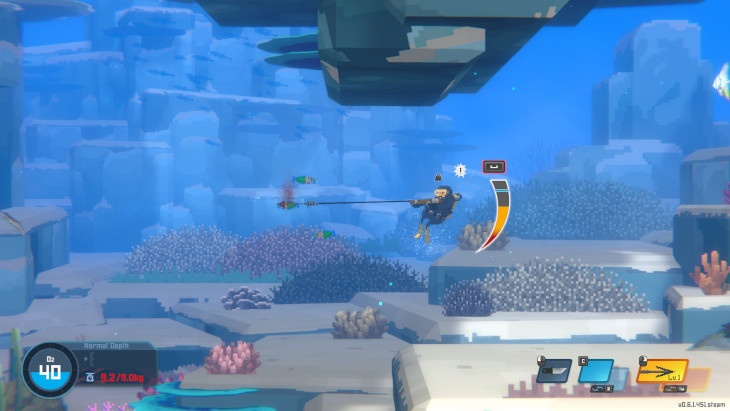
So it’s been about 4 years since we’ve last posted a video game review on this website. Not intentionally, mind you. Things just worked out that way due to a combination of anxiety, laziness, and just not getting too many new games we felt like reviewing. But we still want to have reviews on the site, even if they aren’t as popular as they were when we started doing this. So expect to see reviews every now and again on the site for games from months or even years ago that we either never got around to, or never thought to do in the first place. And what better place to start than with the first game I bought during the Steam Holiday Sale this year… Look, I tried to come up with a justification why I chose Dave the Diver as my first review in 4 years and that was the best I could come up with, what do you want from me?
Dave the Diver is the second incredibly popular fishing based “indie” game released in 2023, and that’s a weird sentence to type out. But where Dredge leaned into the inherent horror of being alone at sea with a Lovecraftian bent to it and single, solid gameplay loop, Dave the Diver goes in the exact opposite direction with a light-hearted, comedic tone and a more scattershot approach to gameplay while still never straying from their equally solid loop.
In Dave the Diver, you play as Dave, a diver who gets talked into managing a sushi restaurant in the Blue Hole, a bizarre part of the ocean where the geography and fish change every day. The game is largely split between day and night. During the day you go diving, where you venture out into the Blue Hole with a spear gun and collect fish. Once you’ve caught your limit, you then head to yout sushi restaurant, where you have to manage the nightly menu, the staff, the ingredients, and the customers as they rush in and place their orders. Working the restaurant gets you the money necessary to upgrade your fishing gear including your oxygen supply, your carrying capacity, and your suit. These upgrades let you go deeper into the Blue Hole so you can catch new and bigger fish, which then opens up new and better recipes for the restaurant, which earn you more money, and so on. It’s a really simple but satisfying loop that plays into the “one more run” mentality, where every successful dive or night at the restaurant opens up new things to play with or sets a new score for you to try to beat.
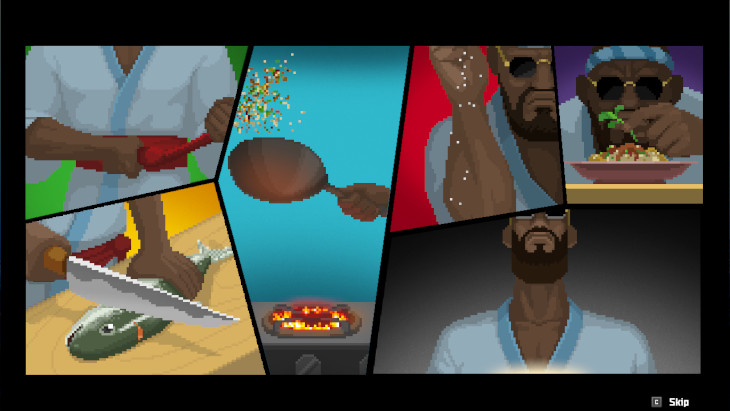
Diving can be done (for the most part) twice an in-game day. You head out into the Blue Hole with a spear gun, secondary gear like mines or underwater scooters, and a gun. Not every fish in the Blue Hole will just come quietly. Sharks, eels, lionfish, and boss fights with unique named fish are all waiting in the depths and they’ll be hard to handle with just your spear gun.
That being said, your spear gun is going to be your best friend throughout this game. It’s your main method of catching fish for the majority of the game, and it’s the only item you can’t unequip. You’ll also find equipment chests randomly placed around the Blue Hole that will give you upgrades to your spear gun, like increased damage and various damage types and effects. You won’t be able to keep these upgrades, though, as every piece of gear you get in a dive goes away once you finish that dive. You can also find other weapons in these crates, and these you actually can get to keep. If you find and equip a gun 2-3 times over the course of multiple dives, you unlock that gun’s blueprint and can craft it and upgrade it in between dives. There’s not a huge number of guns, a total of 8 in the game, so you’ll find a gun you like pretty early on and just focus on upgrading that one. There are melee weapon options, too, but I found those to be largely unimportant. Melee isn’t really a crucial part of the combat, so the only melee weapon that was actually useful to me was the pickaxe, which let you mine certain ores once you get to the lower depths.
All diving is done in this side-scroller style, with limits as to how far you can go left or right and different regions at set depths. Each time you dive the topography of the Blue Hole changes, but each region has the same basic features with a couple of set landmarks that stay in roughly the same place from dive to dive. The landmarks and limits do a lot to help you place yourself from dive to dive. Since you have no map and the world changes every time you dive, it could easily become confusing as to where you are in the world. But after a couple of dives you very quickly get used to the Blue Hole and can navigate it pretty easily.
The side scrolling nature of the diving does make the combat tricky sometimes, though. Using the spear gun or any other gun requires you to stop moving and aim, but you can only aim in 1 of 2 arcs, facing left or right. If a hostile fish is too far above or below you, you’ll need to reposition or wait for them to get into your firing arcs. And these fish are, understandably, way more maneuverable in the water than you are. Your swim speed is largely static throughout the game, with an upgradeable dash. But the dash uses your limited oxygen supply, which also serves as the timer for how long you can stay on this dive and as your health. Running into hazards and hostile fish attacks picks away at your oxygen supply, and given how you move, I found myself stuck in a fish’s turning radius just getting rocked more than once. You can find oxygen tanks and quick refills around the environment to keep you alive, but dying doesn’t do much more than annoy you. When you run out of oxygen, you get sent back to the surface and lose everything from that dive except for one item that you choose.
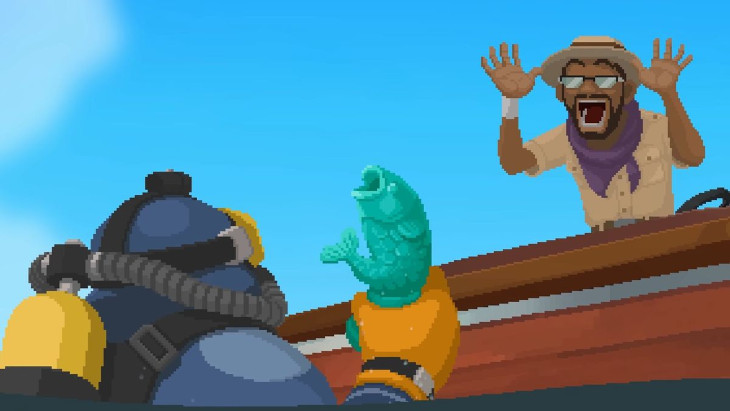
Once you’re finished diving, you then have to head to the sushi restaurant for the night shift. This works like any other restaurant management game you’ve played. Customers come in and order, then you grab the order once it’s ready and run it to the customer. If you take too long, the customer will get mad and leave. Drinks are also introduced and each comes with a little minigame that does break up the food delivery. Eventually you can start hiring and training staff to take over some of the jobs for you, like making fresh wasabi or cleaning up dishes left behind by customers. There is a lot to juggle with the restaurant after the first few hours, but once you unlock the staff things get a lot easier and more manageable.
And from there the subsystems continue to expand. You get a fish nursery, where some of the fish you catch come with eggs that you can grow and have a steady supply of fresh ingredients. You get a farm where you grow and harvest fresh veggies and eggs from chickens you raise. You get an underwater farm where you grow different kinds of seaweed in a less engaging version of the other farm. But then there’s all the one-offs. Rhythm games, infinite runners, stealth sections, boat chases, bullet hell arcade shooters, Pokédex style fish collection. All of these and more that I’m probably forgetting show up once, maybe twice, and then are never seen or heard from again. There’s an item that I got, maybe 15 hours into my playthrough, that I used exactly once 3 hours after I got it. It’s talked about like it’s something that will be useful for that region of the game, but never came up after the one time I used it. This is what I meant when I said the game had a scattershot approach. It introduces this solid core loop, then also throws a dozen different systems at you and most of them just glance off you. While it does vary the gameplay up and keep it from getting stale, more often than not I was left more confused than anything else about what just happened.
Outside of all the subsystems and fishing, Dave the Diver is carried by its tone and its pretty shallow but charming cast. You’ve got Bancho, a sushi chef who cares more for the experience of his dishes than their appearance; Dr. Bacon, an excitable researcher studying the mysterious civilization of the Sea People; Cobra, an eccentric friend of Dave’s who brings him in to manage the restaurant and dive in the Blue Hole in the first place; Duff, your typical hikikomori and weaponsmith; and of course, Dave, our put upon diver who keeps having shit thrown at him but always does what he can to help. Delivered through really well drawn anime-inspired pixel art, it’s a tone that we’ve seen before but one that still manages to keep the game feeling light and with a decent sense of humor about itself.
Dave the Diver is a fun, if a little all over the place, little game. Managing to combine the elements of Diner Dash and roguelikes into an engaging experience, it mainly stumbles under the weight of all these half baked ideas it throws at you. With a well-executed but slightly stale style, it all comes together in the end in an enjoyable experience that I would absolutely recommend.

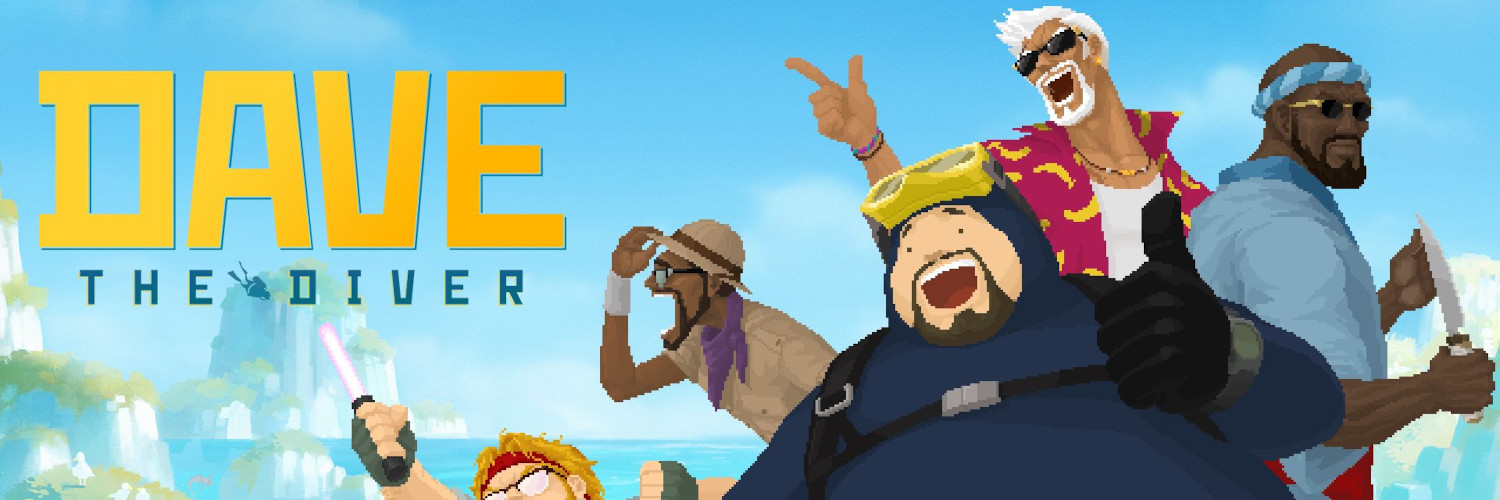
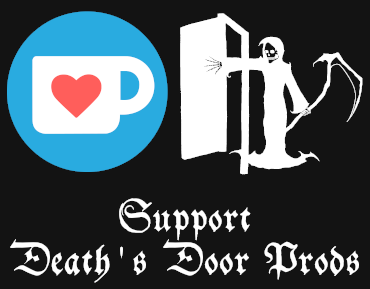

Add comment